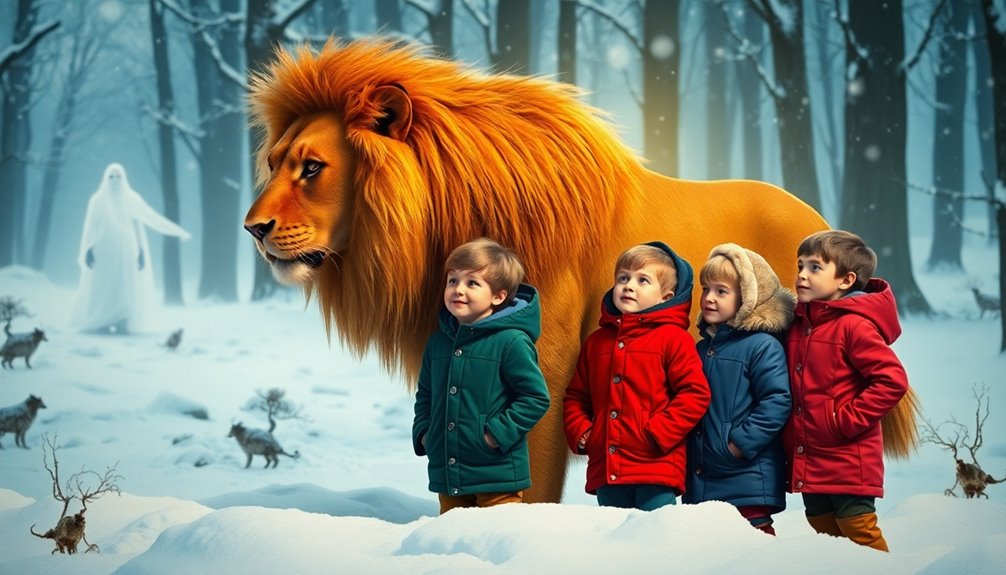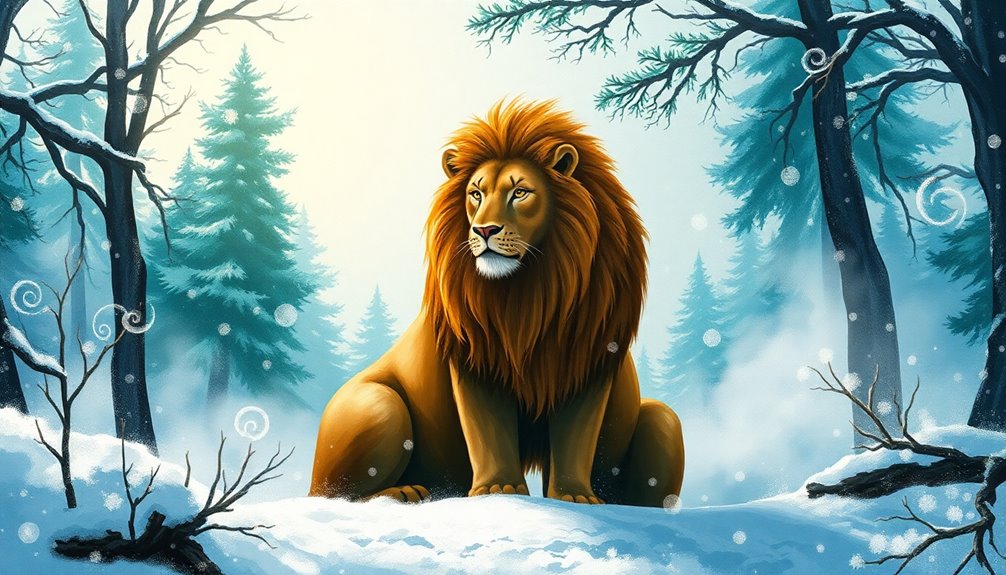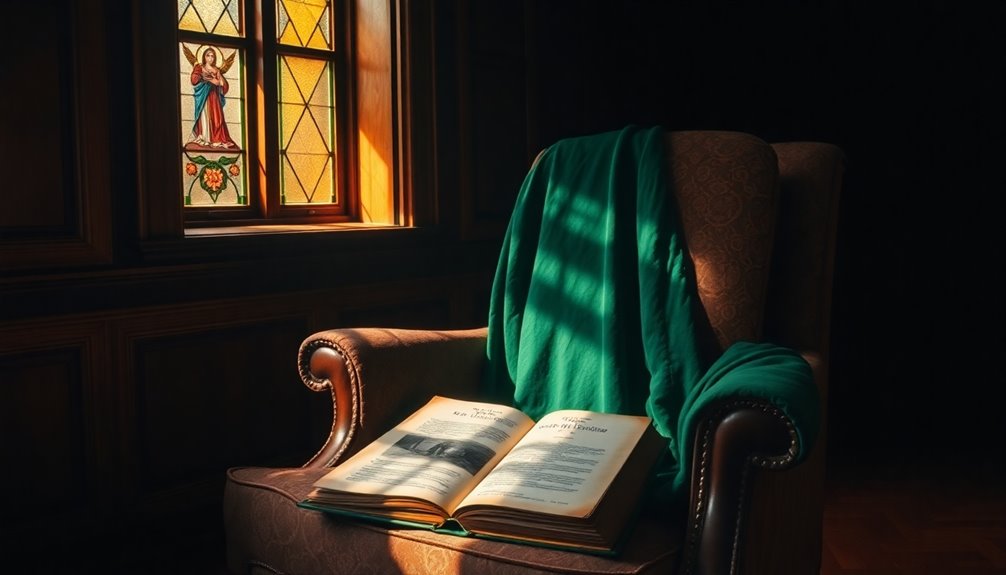C.S. Lewis is the brilliant author behind "The Lion, the Witch, and the Wardrobe," the first book in his famous Chronicles of Narnia series. Born in 1898, Lewis served in World War I and later studied literature at Oxford. He conceived Narnia as a teenager, inspired by a vision of a faun in the snow. After years of development, he completed the manuscript in 1949, and it was published in 1950. This enchanting story not only captivates readers with its themes of courage and redemption but also invites deeper exploration of its characters and influences.
Overview of C. S. Lewis

Although Clive Staples Lewis, better known as C.S. Lewis, was born on November 29, 1898, in Belfast, Ireland, his legacy as an author and scholar is immense.
After serving in the British Army during World War I, he studied at Oxford University, focusing on English literature. Lewis's conversion to Christianity at age 32 deeply influenced his writing, especially in the beloved Chronicles of Narnia series. The first book, The Lion, the Witch and the Wardrobe, was published in 1950 and introduced readers to the magical world of Narnia and the noble lion Aslan. Through his engaging tales, Lewis captivated generations of children, sparking their imaginations and instilling profound themes of faith and courage. His works are enriched with spiritual symbolism that explores deeper moral lessons and themes throughout the narrative. Additionally, Lewis's storytelling often reflects the conflict between tradition and individuality, mirroring the emotional struggles faced by his characters. The narrative's exploration of dystopian themes resonates with the cautionary tales found in other literary works, highlighting the importance of individual freedom against oppressive systems.
Background of The Chronicles
The Chronicles of Narnia isn't just a whimsical journey; it's a carefully crafted series that has captivated readers since its first book was published in 1950.
You'll discover key characters like Aslan and the White Witch, who embody the epic struggle between good and evil. The series reflects themes of fear, courage, and moral dilemmas that echo the historical challenges faced by individuals resisting tyranny. Additionally, the narrative's exploration of social realities enhances the depth of its characters and their struggles.
Let's explore the publication history and the rich tapestry of characters that make Narnia unforgettable. The themes of collective action and resistance resonate throughout the series, mirroring the historical struggles against oppression and tyranny.
#
Publication History
Overview
When C.S. Lewis published "The Lion, the Witch and the Wardrobe" on October 16, 1950, he introduced readers to the magical world of Narnia. This first book in his beloved series, The Chronicles of Narnia, captivated children and adults alike, leading to immense popularity and critical acclaim.
Over the next six years, Lewis released a total of seven novels, establishing the series as a cornerstone of children's literature. The U.S. publication rights were held by Macmillan, resulting in various editions that sometimes altered the order of the books.
Key Characters Overview
Narnia is filled with memorable characters, each playing an essential role in the unfolding story.
The Pevensie siblings—Peter, Susan, Edmund, and Lucy—bring unique traits and undergo significant growth as they navigate their adventures.
Aslan, the Great Lion, represents good and justice, making a profound sacrifice for Edmund and ultimately leading the fight against the White Witch.
This formidable antagonist, also known as Jadis, casts a chilling eternal winter over Narnia, fearing the Pevensies' prophecy.
Supporting characters like Mr. and Mrs. Beaver guide the children to Aslan, embodying loyalty, while Tumnus, the faun, befriends Lucy and faces the Witch's cruelty.
Their guardian, Professor Kirke, believes Lucy's tale, connecting the siblings to Narnia's enchanting reality.
## Publication History

- The publication history of "The Lion, the Witch and the Wardrobe" is quite fascinating.
- S. Lewis completed the manuscript in March 1949, but the book didn't hit the shelves until late 1950, published by Geoffrey Bles. Initially, it had a limited readership, yet it marked the beginning of the beloved "Chronicles of Narnia" series. The series has drawn comparisons to various literary works, including historical mystery novels like The Lost Apothecary, which share themes of hidden truths and empowerment.
Over time, the book's popularity soared, becoming the most widely held title by Lewis in libraries. By 2003, it ranked ninth in BBC's The Big Read poll and made it onto *Time*'s list of 100 best English-language novels in 2005. The story's themes of courage in the face of evil resonate with readers, similar to the struggles faced by characters in historical narratives.
Since its release, "The Lion, the Witch and the Wardrobe" has remained in print, helping the series sell over 100 million copies worldwide. The enduring success of the book reflects its resilience against adversity, much like the themes explored in Louis Zamperini's survival story in *Unbroken*.
Plot Summary
In "The Lion, the Witch and the Wardrobe," you follow the Pevensie siblings as they escape the chaos of WWII and stumble into the enchanting world of Narnia.
Lucy's discovery sets off a chain of events, leading to Aslan's ultimate sacrifice to save Edmund and the fierce battle against the White Witch. This story echoes the themes of resilience and courage, which are also prevalent in many narratives about strong female leads in historical fiction. The journey of the Pevensie siblings illustrates the power of unity and collaboration as they work together to overcome the formidable forces of evil.
Their journey not only brings victory but also fulfills a prophecy, crowning them as the true rulers of Narnia. This epic quest showcases themes of friendship and bravery as the siblings unite to confront their fears and protect their newfound home.
Siblings' Evacuation Journey
Four siblings—Peter, Susan, Edmund, and Lucy—find themselves evacuated from war-torn London to the tranquil countryside, where they're placed in the care of an old Professor.
The Pevensie children adjust to their new surroundings, trying to make sense of the uncertainty brought on by World War II. As they explore the Professor's large home, Lucy becomes curious about an antique wardrobe.
This wardrobe will soon lead her on an incredible adventure. Feeling a mix of excitement and apprehension, the siblings navigate their new life, unaware that their journey in Narnia is about to begin.
Their evacuation marks not just a physical relocation but a pivotal moment that will change their lives forever as they step into a world filled with magic and danger.
Lucy's Discovery of Narnia
As Lucy Pevensie explores the antique wardrobe in the Professor's home, she stumbles into the magical land of Narnia, instantly captivated by its wonders.
There, she meets Mr. Tumnus, a faun who becomes her friend and shares that Narnia is under the spell of the White Witch, trapped in endless winter.
Though her first visit is brief, Lucy rushes back to tell her siblings, but they don't believe her story, leaving her feeling isolated.
On her second visit, she discovers Mr. Tumnus has been arrested by the White Witch for aiding her.
This revelation strengthens Lucy's resolve to help save Narnia, setting the stage for her siblings' eventual involvement in the battle against the oppressive White Witch.
Aslan's Sacrifice and Victory
When the fate of Narnia hangs in the balance, Aslan's selfless sacrifice on the Stone Table becomes a pivotal moment in the struggle against the White Witch.
He willingly gives his life to save Edmund, who betrayed his siblings, embodying themes of redemption and forgiveness. The White Witch believes this act guarantees her rule, unaware of the deeper magic that governs Narnia.
After his death, Aslan resurrects, showcasing hope and the power of good. He then rallies the Pevensie siblings and various creatures of Narnia to confront the White Witch.
In a climactic battle, Aslan leads the charge, ultimately securing victory over her tyranny and restoring peace to Narnia, fulfilling the prophecy and crowning the Pevensies as rightful Kings and Queens.
Main Characters

In the enchanting world of Narnia, the main characters each bring unique strengths and flaws that contribute to the story's depth.
Peter Pevensie, the eldest sibling, shows bravery and leadership, eventually becoming King Peter the Magnificent after defeating the White Witch. His character arc mirrors those of iconic detectives in literature, such as Sherlock Holmes, who also exemplify courage and intellect in the face of adversity. This journey of personal growth reflects the societal transformations experienced by characters in epic narratives like *Gone With the Wind*.
His sister, Susan Pevensie, initially skeptical, embodies nurturing and wisdom, earning the title Queen Susan the Gentle.
Edmund Pevensie starts off as a betrayer, siding with the White Witch, but redeems himself and becomes King Edmund the Just after recognizing Aslan's sacrifice.
Lucy Pevensie, the youngest, discovers Narnia first and represents innocence and courage, ultimately crowned Queen Lucy the Valiant.
Aslan, the great lion, symbolizes good and sacrifice, playing a pivotal role in the battle against the White Witch. Additionally, the themes of forbidden love and social hierarchy resonate with the complex relationships found in Victorian literature, enhancing the depth of the characters' journeys. The interplay of personal struggles with historical events, similar to that in *Gone With the Wind*, showcases resilience and growth in the face of adversity.
Writing Process
When you explore the writing process behind Narnia, you'll uncover the inspiration that sparked C. S. Lewis's imagination at just 16 years old.
You'll see how key characters, like Aslan, developed and transformed during the journey of writing.
Finally, you'll trace the manuscript's completion in 1949 and its journey to publication in 1950.
Inspiration for Narnia's Creation
Although C.S. Lewis began his journey into Narnia with a vivid vision of a faun in a snowy wood at just 16, the story evolved considerably over time.
As he grew, his dreams about lions inspired the character of Aslan, who became the narrative's guiding force.
Initially, Lewis's drafts featured various characters without the Christian themes that later enriched the tale.
By the time he turned 40, he was dedicated to writing "The Lion, the Witch and the Wardrobe," completing it in March 1949.
When it was published in October 1950, it marked the beginning of the beloved Chronicles of Narnia series, enchanting readers with its enchanting blend of fantasy and profound inspiration.
Development of Key Characters
As C.S. Lewis developed "The Lion, the Witch, and the Wardrobe," he crafted memorable characters that resonate with readers. Each character serves a unique purpose within the narrative, reflecting essential themes. You can see this in:
- Aslan the Lion: A symbol of sacrifice and redemption, he unites the story's arc.
- Lucy Pevensie: Inspired by Lewis's childhood, she embodies innocence and bravery as the first to enter Narnia.
- Edmund Pevensie: His journey illustrates betrayal and redemption, as he initially succumbs to the White Witch's temptations but finds forgiveness through Aslan's grace.
- The White Witch: A powerful antagonist, she represents evil, contrasting sharply with Aslan's goodness.
Together, the Pevensie siblings portray diverse human qualities, enriching the narrative's depth.
Manuscript Completion and Publication
C.S. Lewis began crafting "The Lion, the Witch, and the Wardrobe" at just 16, but it wasn't until March 1949 that he completed the manuscript.
Over the years, he considerably developed the narrative structure, influenced by his wartime experiences. These circumstances deeply impacted the themes he explored, leading to a richer story.
Initially, the drafts included different characters and storylines, but Aslan's unexpected emergence became pivotal to the plot.
After a limited readership in 1949, the book finally saw publication on October 16, 1950, through Geoffrey Bles.
This journey from manuscript completion to publication illustrates how Lewis's creativity thrived despite the challenges of his time, ultimately bringing the magical world of Narnia to life.
Illustrations and Artwork

Illustrations breathe life into the pages of "The Lion, the Witch and the Wardrobe," capturing the essence of Narnia's enchanting world. Created by Pauline Baynes, her detailed and imaginative artwork enhances the reader's experience, allowing you to visualize this magical world vividly.
Consider these highlights about Baynes's illustrations:
- 43 illustrations in British editions, enriching the narrative.
- Critical acclaim that solidified her role in the Narnia series.
- Artwork restoration in the 1994 HarperCollins edition, reintroducing her original style.
- Complementary to Lewis's narrative, making the story more immersive.
Her illustrations not only contributed to the book's success but also remain synonymous with the timeless allure of Narnia.
Themes and Symbolism
The enchanting world of Narnia is rich with themes and symbolism that resonate deeply with readers. The central theme of good vs. evil shines through Aslan, who exemplifies goodness and sacrifice, and the White Witch, who represents tyranny and malevolence.
Aslan's death and resurrection symbolize profound redemption, mirroring Christian ideals of grace and forgiveness. The story emphasizes moral choices, particularly through Edmund's betrayal, showcasing the path to redemption he ultimately takes.
Prophecy plays a crucial role, hinting at the White Witch's downfall and the return of peace in Narnia, highlighting ideas of destiny.
Finally, the journey of the Pevensie siblings illustrates their transformation from ordinary kids into noble rulers, embodying growth and discovery throughout their adventure.
Cultural Impact

When you think about the cultural impact of "The Lion, the Witch and the Wardrobe," it's clear that its literary legacy is immense, influencing countless readers and writers.
Its adaptations across film, stage, and audio formats showcase how the story's themes resonate in various contexts.
Plus, the series has shaped the fantasy genre, inspiring a new generation of tales filled with wonder and moral complexity.
Lasting Literary Legacy
Cultural impact often shapes how stories resonate across generations, and "The Lion, the Witch and the Wardrobe" stands as a prime example of this phenomenon.
Its lasting literary legacy is evident in the way it transcends boundaries and connects with readers worldwide.
Consider these key points:
- Over 100 million copies sold globally.
- Translated into over 47 languages, increasing accessibility.
- Recognized in Time magazine and BBC's The Big Read poll.
- Commonly featured in schools as a top childhood read.
The book's exploration of good versus evil, sacrifice, and redemption has inspired countless discussions and influenced both readers and writers in the sphere of children's literature.
Its impact will surely echo for generations to come.
Adaptations and Interpretations
Adaptations of "The Lion, the Witch and the Wardrobe" showcase its powerful impact on popular culture. The 2005 film, directed by Andrew Adamson, grossed over $745 million, proving the story's universal appeal.
Numerous stage productions, audio dramas, and animated adaptations highlight how Narnia continues to resonate with audiences of all ages. Critics often discuss its cultural impact, recognizing the book as one of the 100 best English-language novels by *Time* magazine.
Its allegorical interpretation invites conversations about morality and faith, making it a staple in literature and theology courses. With over 120 million copies sold, this classic remains significant in children's literature, influencing future generations and ensuring its place in the hearts of many.
Influence on Fantasy Genre
The influence of "The Lion, the Witch, and the Wardrobe" on the fantasy genre is undeniable, shaping the landscape of children's literature for generations.
With over 100 million copies sold, this classic has inspired countless authors and established a framework for portal fantasy. Its themes of good versus evil and redemption resonate throughout fantasy narratives, reinforcing essential moral lessons.
- Blends myth and allegory seamlessly
- Pioneered the portal fantasy subgenre
- Encouraged renewed interest in fantasy literature
- Recognized as a timeless classic in literature
Through adaptations into films and other media, its cultural impact continues to thrive, ensuring that its legacy within the genre remains strong.
Reception and Criticism
Although "The Lion, the Witch and the Wardrobe" initially faced a lukewarm reception, it has since become a beloved classic.
At first, some critics viewed it as overly moralistic and simplistic. However, as time passed, the book gained significant acclaim, securing its place in children's literature.
You'll find it praised for its imaginative world-building and rich character development.
While some debate the implications of its religious allegory, the novel sparks essential discussions on morality, faith, and the nature of good and evil.
Today, it remains a widely read and studied work, ranked among the best in English-language novels, showing how perceptions can shift and evolve over time, ultimately highlighting its enduring cultural relevance.
Adaptations in Media

Narnia's impact extends well beyond the pages of C.S. Lewis's original work. You'll find its magic in various adaptations across different media, enchanting audiences of all ages. The successful film released in 2005 grossed over $745 million, showcasing visually stunning effects and a faithful narrative.
Additionally, stage adaptations have graced theaters, featuring prominent productions by the Royal Shakespeare Company.
Consider these notable adaptations:
- The 2005 film with Tilda Swinton and Jim Broadbent
- Stage performances, including a musical by Andrew Lloyd Webber
- Audio dramas and graphic novels
- Animated versions
These adaptations have solidified Narnia's legacy, sparking renewed interest in the novels and discussions on future film and television projects.
Influence on Literature
While many stories have shaped the fantasy genre, few have left as profound an impact as "The Lion, the Witch, and the Wardrobe." Selling over 100 million copies worldwide, it's become a cornerstone of children's literature, influencing both young and adult authors.
C.S. Lewis's masterful blend of mythological elements and themes of good vs. evil resonates deeply, providing a framework for countless narratives. The exploration of redemption in Narnia has sparked inspiration in writers across generations, encouraging them to weave similar themes into their own stories.
This book not only shaped modern fantasy literature but also paved the way for a resurgence in children's fantasy during the mid-20th century, highlighting its lasting significance in literary history.
Religious Undertones

Many readers find that "The Lion, the Witch and the Wardrobe" resonates on a deeper level due to its rich religious undertones. As a Christian allegory, it explores profound themes such as redemption, embodied in Edmund's journey from betrayal to forgiveness.
Consider these key elements:
- Aslan represents Christ through his sacrificial death.
- His resurrection symbolizes hope and victory over evil.
- The White Witch stands for sin and the moral struggle in Narnia.
- Lewis described his stories as "supposal," inviting diverse interpretations.
These layers invite readers to reflect on faith, sacrifice, and the eternal battle between good and evil, making the narrative both engaging and thought-provoking.
Legacy of Narnia
The legacy of the Chronicles of Narnia is nothing short of monumental, with over 120 million copies sold worldwide, securing its place as one of the best-selling book series in history.
C.S. Lewis's masterful storytelling, rich with themes of good versus evil and redemption, has left an indelible mark on children's literature.
Translated into over 47 languages, Narnia's impact spans diverse cultures, engaging readers of all ages.
The successful film adaptation in 2005 introduced Narnia to a new generation, reigniting interest in the original books.
Lewis's work continues to influence countless authors and filmmakers, prompting discussions on morality and faith.
Narnia's enduring legacy invites you to explore its timeless messages and revel in its enchanting world.
Conclusion
In the grand tapestry of children's literature, C. S. Lewis wove a tale that's as timeless as your neighbor's holiday lights—always bright, never quite out of season. "The Lion, the Witch, and the Wardrobe" isn't just a story; it's a magical domain where talking animals deliver life lessons, while you ponder if your wardrobe could double as a portal. So, next time you open your closet, remember: you might just stumble into a world far more exciting than your daily routine!



